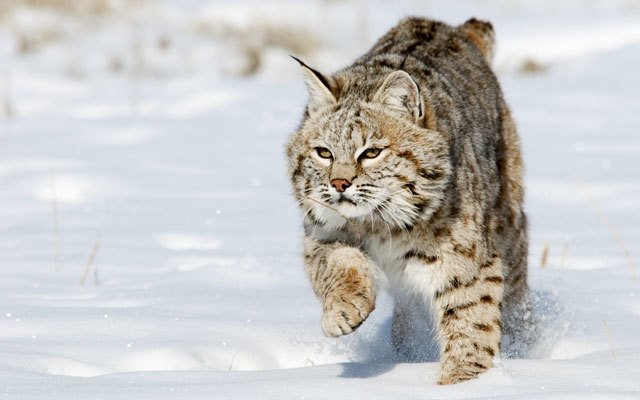
Bobcats are incredibly adaptable animals found across North America. Their ability to adjust to different habitats means they have a varied diet that can change based on what’s available in their environment. Imagine being able to dine at a buffet that changes every season—that’s the life of a bobcat! So, grab a cup of coffee and get comfortable as we explore the dietary habits and hunting styles of these remarkable felines.
What Do Bobcats Eat?
Bobcats are opportunistic feeders, which means they eat whatever’s available. Their diet primarily consists of small mammals, birds, and sometimes reptiles. This varied menu allows them to thrive in different habitats, from forests to swamps.
You might be surprised at how diverse their meals can be. They primarily hunt:
- Rabbits: These little guys are a bobcat’s favorite. With their quick movements and soft fur, rabbits are easy prey.
- Rodents: Mice, voles, and squirrels can often be found on the menu.
- Birds: Being nimble, bobcats can also take down birds, especially when they’re on the ground.
- Deer: While this isn’t a daily staple, they can go after younger or weaker deer if the opportunity arises.
In addition to these, bobcats occasionally snack on insects and fruits. Yes, you read that right! They’re not picky eaters, and they will consume whatever they can find to fill their bellies.
How Do Bobcats Hunt?
When it comes to hunting, bobcats have developed several strategies that showcase their agility and keen senses. They’re like the stealthy ninjas of the animal kingdom, using their environment to their advantage.
Bobcats primarily use a method called “stalking.” This involves moving slowly and quietly to avoid detection from their prey. They’ll often crouch low and sneak up on unsuspecting animals, waiting for the perfect moment to pounce.
Here’s how it usually goes:
1. Spotting Prey: Bobcats have excellent vision and can spot movement from a distance.
2. Creeping Forward: They silently lower their bodies, inching closer without alarming their target.
3. The Pounce: When they’re close enough, they launch themselves forward using their powerful hind legs.
This technique relies on patience and timing, making them successful in their hunts.
The Role of Territory in Hunting
Bobcats are fiercely territorial animals. Each one claims a specific area that provides enough food and shelter. This territory can range from 1 to 50 square miles, depending on food availability and competition from other bobcats.
Having a defined territory helps them *maximize their hunting efficiency*. By knowing their land well, they can take advantage of the best spots for stalking prey. Their territories often overlap slightly with others, but they generally avoid direct confrontations.
Interestingly, male bobcats usually have larger territories than females. This is mainly because they need to cover more ground in search of mates. The more space they have, the better their chances of finding food and partners.
Hunting During Different Seasons
Depending on the season, bobcats adjust their hunting strategies and dietary choices. Let’s break it down a bit.
– Spring and Summer: During these warmer months, the bobcat’s diet is rich in small mammals and birds. The abundance of young rabbits and rodents makes for a feast. They often hunt during twilight, when prey is most active.
– Fall and Winter: As temperatures drop, food can become scarcer. Bobcats may have to rely more on what they can find in their territory. They’ll hunt larger prey, like deer, if the opportunity presents itself. They also become more resourceful, using their keen senses to locate food buried under snow.
Adjusting their hunting methods to fit the season helps these cats survive and thrive in varying conditions.
The Importance of Stealth and Camouflage
A bobcat’s ability to remain undetected is crucial for successful hunting. Their fur pattern—typically a mix of browns and blacks—helps them blend into their surroundings, making it harder for prey to spot them.
Think about it: When you wear camouflage, you’re hard to find, right? The same goes for bobcats. They rely on their spots and stripes to hide in grass, bushes, or shade while stalking.
Additionally, their quiet movements and slow, deliberate pace play a significant role in their stealth. Unlike larger predators that might rely on sheer strength, bobcats excel in avoiding detection.
Challenges in Hunting
Despite their skills, bobcats face challenges that can impact their hunting success. Habitat loss, due to urban development or agriculture, can reduce prey availability and hunting grounds.
They also deal with competition from other predators, like coyotes or larger cats. When food is scarce, they may find themselves competing for the same meal, leading to increased stress and lower survival rates.
Understanding these challenges highlights the adaptability of the bobcat. They’ve survived for generations, but like many wildlife species, they need protection and support to continue thriving.
Bobcats are incredible creatures that blend adaptability with impressive hunting strategies. Their varied diet, keen senses, and stealthy approaches to hunting play a crucial role in their survival. By understanding how they hunt and what they eat, we can appreciate the balance of nature and the importance of conserving their habitats.
Whether you encounter a bobcat in the wild or just read about them in articles, you’ll gain a greater respect for these elusive hunters. Let’s be mindful to protect their homes so they can continue thriving for generations to come.
